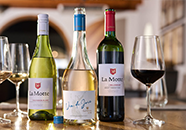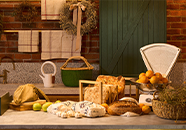
“A traditional terrine is something slightly different to what we as South Africans understand”, says La Motte’s Culinary spokesperson and Food Historian, Hetta van Deventer-Terblanche. “Most of us think of a terrine as a cold dish set with gelatine or jelly, but a terrine actually has more in common with a pâté!”
Hetta shares this explanation from Anne Willan‘s Complete Guide to Cookery: Traditionally terrines and pâtés were distinguished by the fact that a pâté was baked in a pastry and a terrine in an earthenware mould called terrine – from the French terre, meaning earth. Terrine refers to the baked dish as well as the dish itself. (Take care not to confuse terrine with the vessel for soups and stews – the Tureen!)
As we all know, and acknowledged in Anne Willan’s book, the differentiation between terrine and pâtés has become less distinct and definitions, nowadays, have a much looser meaning. Some pâtés are even served in terrine moulds or tins traditionally reserved for the terrine!
The original French terrines came to the Cape with the French Huguenots and became part of the Cape’s history of Charcuterie. Unfortunately most of the knowledge and recipes have gone lost, but we can still refer to the French origin of the Cape version of terrine – especially during the season of French celebration in the Franschhoek Valley!
It is also for the annual Franschhoek Bastille Festival, that the La Motte Farm Shop (re-opening on 13 July) stocks French culinary heritage in the form of beautiful terrines – the earthenware moulds or pots in which terrines are traditionally made. In the colours of the French flag, the red and blue Chasseur cast iron terrines (R485 each) have been produced in France’s Ardennes region, since 1924. Sought-after for its heat retention properties, each piece of Chasseur has been individually sand cast, then enamelled twice to ensure edges are sealed and the product protected against corrosion. A final layer adds unmatched curability and the distinct vibrant colour.
Terrine moulds have tight-fitting lids that are usually sealed with a paste of flour and water during cooking. To keep the mixture moist, the mould is always lined with fat. Terrines are usually cooked in a bain-marie for even heat diffusion and after baking, the terrine is cooled and pressed to ensure a tight texture that will be easy to slice.
Terrines make for a lovely lunch, supper or light meal and is a versatile companion to wine. According to British wine writer, Suzie Atkins: “The French like it sweet, the Brits prefer red, except in the West Country, where you might get cider. In short, the drinks that match terrines well (and pâtés, for that matter) are many and varied, so the golden rule to serving Diana Henry’s recipes is simply to make sure everyone has something in their glass.” It depends on the type of terrine, of course, but we find the 2015 Pierneef Syrah Viognier to be quite the match!
Try our recipe for a spiced duck & pistachio terrine.
The terrine takes some time and effort, but it is all worthwhile in the end. It is the perfect accompaniment to a freshly baked baguette and a glass of La Motte’s Pierneef Syrah Viognier. It can also be a lovely light meal with a side salad – and the glass of wine, of course!”
Recipe: Spiced Duck & Pistachio Terrine
The recipe is egg and gluten free and easily serves 4 to 6 people.
Ingredients
300 g Duck meat. Deboned, with skin and excess fat removed. Diced.
190 g Pork belly, skin removed and diced
80 g whole pistachio nuts, lightly toasted
30 g water
30 g red port
10 g fine salt
2 g ground nutmeg
2 g ground aniseed
1 g ground cinnamon
3 g coarse ground black pepper
1 g ground cloves
1 Tablespoon chopped flat leaf parsley
Method
Pre-heat oven to 165 ⁰C
Prepare a bain-marie bath: Place a clean tea towel at the bottom of a deep oven tray that your terrine mould will fit into.
Brush your clean terrine mould with some rendered duck fat or butter and set aside.
Finely chop the diced duck and pork meat by hand or use the food processor’s mincing attachment to mince the meat. (When using the mincing attachment, remember to first put the meat in the freezer so that the meat is quite cold, but not frozen.)
As soon as your meat is minced or very finely diced, add the rest of the ingredients and mix through thoroughly.
Take a small amount of your terrine mixture and cook it in a pan, to taste and check for seasoning.
Place the mixture into the prepared terrine mould and place the mould into the prepared bain-marie bath.
Add boiling water to the bath until the water comes halfway up the terrine.
Place a meat thermometer into your terrine.
Place bain-marie bath with terrine into the oven and cook until the thermometer reaches 165 ⁰C or the cooking juices run clear.
Remove from the oven and from the water bath and leave to cool.
Now the terrine has to be weighed down. (I use a piece of cardboard that I cut it into the shape of the terrine. I cover it with foil and then cling film and place it onto the terrine. I then put a weight on the cardboard and leave it overnight to be pressed down.)
To preserve the terrine, cover it with rendered duck fat or a jelly of choice. (I prefer a spiced cherry and red port jelly. There are plenty of recipes online.)
Serve with the 2015 Pierneef Syrah Viognier.












